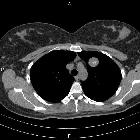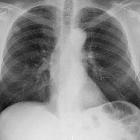pulmonales Hamartom





















Pulmonary hamartomas are benign neoplasms composed of cartilage, connective tissue, muscle, fat, and bone. It is one of the most common benign tumors of the lung and accounts for ~8% of all lung neoplasms and 6% of solitary pulmonary nodules.
Terminology
Pulmonary chondroma has been used interchangeably with pulmonary hamartoma in the past but they should be considered separate entities due to histological differences .
Epidemiology
Patients usually present in the 4 and 5 decades of life and they are very uncommon in children. There is a recognized male predilection (M:F = 2.5:1). Most lesions are diagnosed incidentally.
Clinical presentation
Pulmonary hamartomas are usually asymptomatic and found incidentally when imaging the chest for other reasons. It can occasionally present with hemoptysis, bronchial obstruction, and cough (especially endobronchial types) .
Pathology
Hamartomas may be chondromatous (more common), leiomyomatous, or a mixture. At least two mesenchymal elements are present in them. They are unencapsulated, lobulated tumors with connective tissue septa.
As with any hamartoma it is composed of tissues that normally constitute in the lung and bronchi. The tissue elements, although mature, are disorganized. On rare occasion, they contain principally fatty tissue, in which case they are called lipomatous hamartomas or endobronchial lipomas.
Location
The vast majority of pulmonary hamartomas are located peripherally within the lungs (>90%), with endobronchial hamartomas representing only ~5% (range 1.4-10%) of such lesions .
Typically, hamartomas manifest incidentally as solitary nodules in the periphery of the lung.
Variants
Radiographic features
Often discovered incidentally, they are typically well-circumscribed nodules or masses (usually small) with either smooth or lobulated margins. Approximately 60% have fat and approximately 20-30% have calcification/ossification (popcorn-like) . Cavitation is not seen.
Size is variable: they can be large (>10 cm) but in most cases, they are <2.5-4 cm in diameter .
Growth occurs but is very slow, with a typical volume doubling time of over 400 days .
Plain radiograph
Chest radiography is non-specific, demonstrating a soft tissue attenuation, well-circumscribed mass with either smooth or lobulated margins. Calcification (classically popcorn type) may be seen, which can suggest the diagnosis. Fat is difficult to identify with certainty, although the lesion is typically of low density for its size.
CT
CT is far superior in detecting intralesional fat and calcification. The reported prevalence of calcification in hamartomas on CT varies from 5 to 50% while fat may be identified in up to 60% of hamartomas at CT. The fat components may be localized or generalized within the nodule.
Fat can be recognized by comparing it to subcutaneous fat, and will typically have a Hounsfield measurement of -40 to -120 HU . Presence of fat in a well-circumscribed solitary pulmonary nodule which does not demonstrate significant growth is essentially pathognomonic of a pulmonary hamartoma and no further investigations are required . Unfortunately, fat can only be identified in 60% of lesions. Thin section CT is therefore essential to avoid missing small foci of fat.
Calcification is typically dispersed in the form of multiple clumps throughout the lesion in a popcorn configuration .
MRI
- T1: heterogeneous signal
- mainly intermediate signal
- foci of high signal represent fat
- low signal regions representing fibrous or calcific material
- T2:
- high signal due to fat and cartilaginous components
- low signal regions representing fibrous or calcific material
- T1 C+ (Gd): heterogeneous enhancement is seen
Nuclear medicine
PET-CT
Although uncommon, increased avidity may be seen on FDG-PET. Thus, further investigation with PET-CT of slow-growing, fat-containing masses is unwarranted, confusing, and contributes to patient radiation dose.
Treatment and prognosis
Malignant transformation is exceedingly rare, and a peripheral small hamartoma with no atypical features can be safely left alone, with infrequent follow-up to exclude growth.
In atypical cases, or in cases of endobronchial hamartomas causing distal complications, surgical resection is curative. Rigid transbronchial resection is most frequently employed in the later .
Differential diagnosis
The differential is somewhat dependent on whether fat or calcification is identifiable within the lesion.
If fat is visualized then the differential is narrow, with almost all cases representing pulmonary hamartoma. See differential of fat containing solitary pulmonary nodule.
Presence of calcification also significantly narrows the differential, but to a lesser degree. See differential of a solitary pulmonary nodule with calcification.
If neither fat nor calcification is present, then the differential is that of a solitary pulmonary nodule and is significantly broader. See differential of a solitary pulmonary nodule.
Siehe auch:
- verkalkte Lungenherde
- Hamartom
- solitärer pulmonaler Rundherd
- entzündlicher Pseudotumor der Lunge
- Lungenläsionen mit Fett
- Pneumozytom
- lung calcified hamartoma
- benign neoplasms of the lung
- pulmonale Chondrome
- solitary pulmonary nodule with calcification
und weiter:

 Assoziationen und Differentialdiagnosen zu pulmonales Hamartom:
Assoziationen und Differentialdiagnosen zu pulmonales Hamartom:




